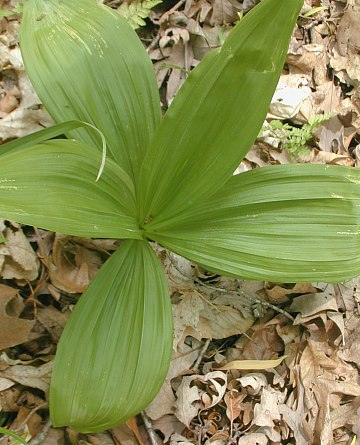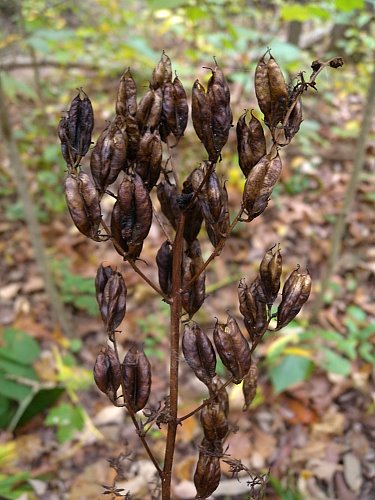
This inflorescence consists of either a narrow raceme or elongated panicle of flowers. On each inflorescence, the upper flowers are perfect, while the lower flowers are staminate (male). The peduncle, lateral branches, and pedicels of the inflorescence are light green and pubescent, becoming dark brown with age. When lateral branches are present, they are 2-8" long and ascending to spreading (usually the former). The pedicels of the flowers are short (less than ½" long). Usually, there are narrow leafy bracts less than ½" long at the bases of the branches and pedicels. Perfect flowers are ½-¾" across, consisting of 6 widely spreading tepals, a small superior ovary, 6 stamens, and 3 styles. The narrow tepals are reddish brown (maroon) overall. The tepals have pairs of dark red glands at their bases, while toward the middle of each tepal there is often a transverse band of pale green or pale yellow. The ovary of each flower is light green, finely short-pubescent, and ovoid-conical in shape. Staminate flowers are the same as perfect flowers, except they lack an ovary and styles. The blooming period occurs from mid- to late summer for about 1 month.

Afterwards, the perfect flowers are replaced by 3-celled seed capsules that become, when they are mature, about ¾-1" long and about one-half as much across. These capsules have 3 longitudinal lobes with sharp ridges; they are usually sparsely pubescent and change color from green to dark brown. Each capsule usually contains only 0-3 seeds, although sometimes there are more. The tan-colored angular seeds are up to ½" long and ¼" across. The root system is rhizomatous. Sometimes vegetative offsets develop from the rhizomes.
Cultivation: The preference is dappled sunlight or light shade, moist conditions, and a rich soil that is often derived from glacial till. This wildflower has very few problems with insects pests and disease organisms. In any given year, entire colonies of plants may fail to produce flowers.
Range & Habitat: The native Wood's Bunchflower is restricted to central Illinois, where it is uncommon. In the past, this wildflower was state-listed as 'threatened,' but it was recently removed from this list as additional colonies of plants were discovered. Wood's Bunchflower is uncommon throughout
Faunal Associations: Almost nothing is known about floral-faunal relationships for Wood's Bunchflower. The maroon-colored flowers are probably cross-pollinated by flies and beetles. The caterpillars of a highly polyphagous moth, Xestia smithii (Smith's Dart), reportedly feed on this or a closely related species. Generally, Melanthium spp. (Bunchflowers) and the closely related Veratrum spp. (False Hellebores) have foliage, roots, and seeds that are considered highly poisonous to mammalian herbivores. There is some evidence that these plants are teratogenic, causing fatal birth defects in sheep. However, it is not uncommon to encounter specimens of Wood's Bunchflower that have been partially eaten by White-Tailed Deer.
Photographic Location: The photograph of the basal leaves was taken on a wooded slope facing a river in Vermilion County, Illinois, while the photograph of the seed capsules was taken in a hilly woodland near a stream in Coles County, Illinois.
Comments: Taxonomists are still divided regarding the classification of this wildflower: Some authorities refer to this species as Melanthium woodii (Wood's Bunchflower), as described here, while others refer to it as Veratrum woodii (Wood's False Hellebore). Perhaps additional genetic analysis will be helpful in resolving this conflict. The large basal leaves of Wood's Bunchflower are very conspicuous. This is one of the tallest wildflowers to bloom in woodlands during the summer, but the flowers are not produced reliably from year-to-year. The reason for this inconsistent flowering is not clear. Wood's Bunchflower is closely related to Melanthium virginicum (Virginia Bunchflower), but the latter species is found in damp sunny habitats. Virginia Bunchflower has white flowers, rather than maroon ones, and its leaves are more slender than those of Wood's Bunchflower. Both species are unusual in having conspicuous glands at the bases of their tepals.